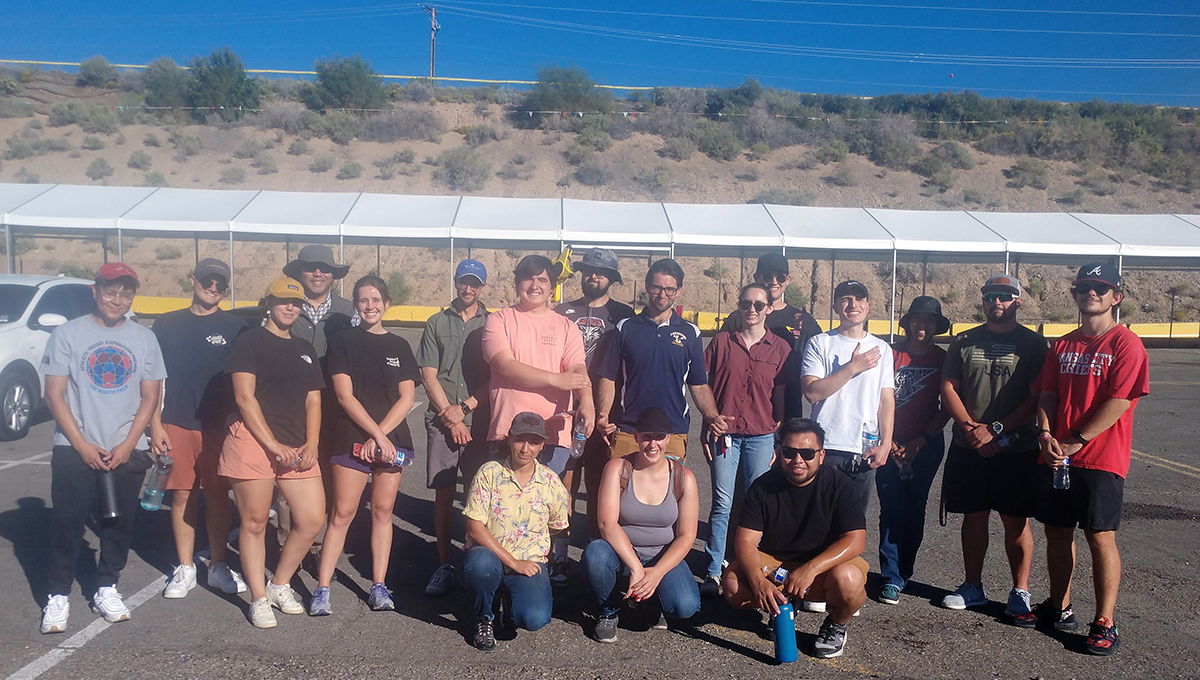Recent News
UNM Engineering Ph.D. candidate named ASCE ‘24 Outstanding Reviewer
August 11, 2025
UNM joins Brown University in national institute focused on intuitive, trustworthy AI assistants
August 6, 2025
UNM Engineering team wins ASEE best paper for work on first-year engineering course
July 17, 2025
New director will enhance interdisciplinary engineering learning opportunities
July 2, 2025
News Archives
School of Engineering students, faculty helping to optimize Balloon Fiesta traffic flow
September 23, 2022 - by Kim Delker

The School of Engineering students who worked on the Balloon Fiesta traffic project.
Faculty and students in The University of New Mexico School of Engineering are continuing their work to optimize the park-and-ride bus service during the Albuquerque International Balloon Fiesta, which will attract tens of thousands of visitors during the annual event Oct. 1-9.
“Our goal is to continue to get the system to work better and better every year,” said Claude Morelli, a research scholar in the Department of Civil, Construction and Environmental Engineering. “We’ve been looking at a lot of data we’ve collected through video monitoring and other means, and we see many little things that can be done to make things better and potentially have a big, positive impact on the guest experience.”
Morelli began his work with Balloon Fiesta in 2019, becoming involved after seeing media reports about the Fiesta’s park-and-ride traffic issues at the 2018 event. He felt that he and his UNM colleagues might be able to lend their expertise to develop engineering-based solutions.
This year is the 50th anniversary of the Balloon Fiesta, and with pandemic restrictions lifted, officials are expecting a big crowd.
Morelli and a team of undergraduate and graduate students are continuing their work for the third year (the event was canceled in 2020 and ran at a reduced capacity in 2021), thanks to $10,000 in funding provided by Albuquerque City Councilor Brook Bassan.
“The funding level isn’t huge, but it enables us to collect high-quality data on the park-and-ride bus operations that we wouldn’t otherwise be able to obtain,” Morelli said. “It also enables us to employ some students and teach them how to enter the data very carefully into our database so that it can be used for research purposes.”
The funding pays for Morelli’s time during the event, days that often begin in the wee hours as crowds begin arriving each day. He has an extensive background in multimodal transportation planning and has been involved with a wide variety of projects in several states, including a traffic mitigation strategy for the Aspen Music Festival and public transit service plans in Colorado and Wyoming resort towns.
He said the project has two main focuses: data collection and analysis, and passenger queuing and system setup.
Morelli has been working with a group of undergraduate students in the School of Engineering who have been analyzing video of bus operations and pedestrian circulation. That means students go through many hours of video collected at the site before and after Balloon Fiesta events, including from a drone, and record many different types of data items into spreadsheets. For example, as people leave Balloon Fiesta Park after each event, the students measure how long it takes to spot buses for loading, open the bus doors, count out bus-load-sized groups of passengers for placement into boarding corrals, load the passengers into the buses, and get the buses on their way. The students also observe similar processes during the inflow period before events take place.
“When you collect data, you start to see patterns, and that leads to recommendations for improvements,” Morelli said. “We hope to offer insights into how Balloon Fiesta might expand the passenger-carrying capacity of its bus service. If the capacity increases are large enough, there should be a noticeable impact on the quality of the park-and-ride experience and even on traffic operations along I-25 and surface streets during Balloon Fiesta events. Currently, Balloon Fiesta buses carry the equivalent of about a lane-and-a-half of freeway capacity in both directions. We hope to be able to bring the system to a level of future operating efficiency that would be equivalent to about two lanes of freeway capacity in both directions.”
Morelli said they are applying something called “queuing theory,” which is the process of managing people in a line. He will be working alongside Su Zhang, an assistant research professor in the Department of Civil, Construction and Environmental Engineering and associate director of the Earth Data Analysis Center, to mark pavement locations at the bus terminals where stanchions, barriers and other devices are installed to create the queues and passenger counting stations.
To make the project work, Morelli has worked closely with an experienced team of Balloon Fiesta transportation professionals, led by Liz Aldaz, park-and-ride bus sites operation manager. She is a dispatcher who oversees nine radio channels for the buses. She works with what she calls “the A Team,” a group of experienced and dedicated transportation officials.
Aldaz has been in the transportation industry 42 years, beginning at age 18 as a school bus driver, a job she did for 36 years. She retired from Rio Rancho Public Schools and is in her sixth year working with Balloon Fiesta. During the event, her day begins at 3 a.m. and ends at 1 p.m.
“We only get about two or three hours of sleep, but I love it. I’m retired, and I do this because it’s a passion,” she said.
Although traffic will undoubtedly be heavy, Aldaz is ready to welcome crowds to the event and provide a safe and enjoyable experience.
“The safety and wellbeing of our passengers is our No. 1 priority, and I couldn’t do it without my A Team,” she said. “It’s going to be amazing, and we’re glad to welcome everyone back.”
The UNM undergraduate students involved in the project receive free Balloon Fiesta tickets as well as course credit. Their involvement was facilitated by the Engineering Student Success Center.
